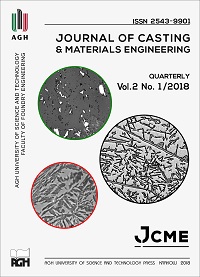Microstructural Characterization and Mechanical Behavior of Copper Matrix Composites Reinforced by B4C and Sea Shell Powder
DOI:
https://doi.org/10.7494/jcme.2018.2.1.24Abstract
This paper investigates the microstructural and mechanical properties of copper metal matrix composites reinforced with B4C and crushed sea shell particles (fabricated using powder metallurgy). In powder form, copper is widely used in structural applications. Copper also possesses very good electrical and thermal conductivity, ductility, and corrosion resistance. B4C is the third-hardest-known material that also possesses excellent toughness and wear resistance. Sea shells are readily available along coastal areas. Therefore, an attempt has been made in this work to investigate the feasibility of its utilization in powder metallurgy. Two batches of samples were prepared. In the first batch, the percentage of boron carbide and copper powder were varied, and seashell powder was not included. In the second batch, the percentages of B4C, copper, and sea shell powder were varied in order to assess the change effected by the sea shell material. The sintered samples of both batches were subjected to microstructural characterization to ascertain the homogeneous distribution of the reinforcements. The microhardness and wear resistance of all of the fabricated samples were assessed. The results confirmed that the inclusion of 2% sea shell powder (by weight) with 10% boron carbide improved the wear resistance and hardness of the composite.
Downloads
References
Celebiefi G., Zeytin S., Bindal C. (2012). The effect of SiC particle size on the properties of Cu-SiC composites. Materials and Design, 36, 633–639.
Moustafa S.F., Abdel-Hamid Z., Abd-Elhay A.M. (2002). Copper matrix SiC and Al2O3 particulate composites by powder metallurgy technique. Material Letters, 53, 244–249.
Wang H., Zhang R., Hu X., Wang C.-A., Huang Y. (2008). Characterization of a powder metallurgy SiC/Cu-Al composites. Journal of Materials Processing Technology, 197(1–3), 43–48.
Olivia M., Mifshella A.A., Darmayanti L. (2015). Mechanical properties of seashell concrete. Procedia Engineering, 125, 760–764.
Adelstein S.J., Vallee B.L. (1961). Copper Recommended Dietary Allowances. Washington, D.C.: National Research Council, Food Nutrition Board, NRC/NAS. 1980, 151–154.
Walker W.R., Keats D.M. (1976). An investigation of the therapeutic value of the 'copper bracelet' – dermal assimilation of copper in arthritic/rheumatoid conditions. Agents and Actions, 6(4), 454–459.
Biurrun A., Caballero L., Pelaz C., Gago A. (1999). Treatment of a Legionella pneumophila – Colonized Water Distribution System Using Copper‐Silver Ionization and Continuous Chlorination. Infection Control and Hospital Epidemiology, 20(6), 426–428.
Fuchsloch J., Brush E.F., (2007). Systematic Design Approach for a New Series of Ultra‐NEMA Premium Copper Rotor Motors. EEMODS 2007 Conference Proceedings, 10–15 June, Beijing.
Lin Y.C., Li H.C., Liou S.S., Shie M.T. (2004). Mechanism of plastic deformation of powder metallurgy metal-matrix composites of Cu-Sn/SiC and 6061/SiC under compressive stress. Material Science and Engineering A, 373 (1–2), 363–369.
Celebi Efe G.F., Altinsoy I., Ipek M., Bindal C. (2011). Some Properties of Cu-SiC Composites Produced by Powder Metallurgy Method. Kovove Materialy – Metallic Materials, 49(2), 131–136.
Günter J. (1999). Copper: Its Trade, Manufacture, Use and Environmental Status, edited by Kundig, Konrad J.A., ASM International, Ohio, Chapter 3: Products, 141–192, Chapter 5: Applications, 331–375.
Stelter M., Bombach H. (2004). Process Optimization in Copper Electrorefining. Advanced Engineering Materials, 6(7), 558–562.
Rickard T.A. (1932). The Nomenclature of Copper and Its Alloys. Journal of the Royal Anthropological Institute of Great Britain and Ireland, 62, 281–290.
Pleger T.C. (2002). A Brief Introduction to the Old Copper Complex of the Western Great Lakes: 4000–1000 BC. Proceedings of the Twenty-seventh Annual Meeting of the Forest History Association of Wisconsin, Oconto, WI, 5 October, 10–18.
Weißgärber T., Lefranc, G., Schulz-Harder, J., Meyer, A. & Stoecker, O. (2003). Cu-SiC composites for thermal management application. Advances in Powder Metallurgy & Particulate Materials, part 6, Metal Powder Industries Federation, Princeton, NJ, 33-40.
Celebi Efe G., Yener T., Altinsoy I., Ipek M., Zeytin S., Bindal C. (2011). The effect of sintering temperature on some properties of Cu-SiC composites. Journal of Alloys and Compounds, 509 (20), 6036–6042.
Celebi Efi G.F. (2010). Development of Conductive Copper Composites Reinforced with SiC. Ph.D. thesis, Sakarya University, Institute of Science and Technology, June 2010.
Schubert T., Brendel A., Schmid K., Koeck T., Ciupiński Ł., Zieliński W., Weißgärber T., Kieback B. (2007). Interfacial design of Cu/SiC composites prepared by powder metallurgy for heat sink applications. Composites: part A: Applied Science and Manufacturing, 38(12), 2398–2403.
Schubert T., Trindade B., Weißgärber T., Kieback B. (2008). Interfacial design of Cu-based composites prepared by powder metallurgy for heat sink application. Material Science and Engineering A, 475 (1–2), 39–44.
Downloads
Published
Issue
Section
How to Cite
Accepted 2018-03-22
Published 2018-03-30


